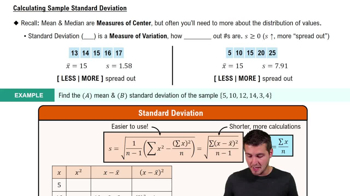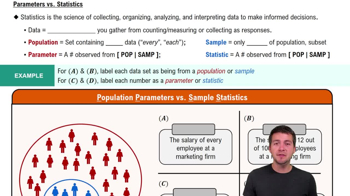Here are the essential concepts you must grasp in order to answer the question correctly.
Regression Equation
A regression equation is a mathematical representation that describes the relationship between a dependent variable (y) and one or more independent variables (x). The equation typically takes the form y^ = b0 + b1x, where y^ is the predicted value, b0 is the y-intercept, and b1 is the slope of the line, indicating how much y changes for a unit change in x.
Recommended video:
Calculating Standard Deviation
Estimation vs. Population Parameters
In statistics, the notation y^ = b0 + b1x uses 'b' coefficients, which are estimates derived from sample data, while y = β0 + β1x uses 'β' coefficients, which represent the true population parameters. The distinction highlights that 'b' values are calculated from sample data, while 'β' values are theoretical and apply to the entire population.
Recommended video:
Parameters vs. Statistics
Predicted vs. Actual Values
The notation y^ indicates predicted values generated by the regression model based on the independent variable(s), while y represents the actual observed values. Understanding this difference is crucial for interpreting regression results, as it helps in assessing the model's accuracy and the extent to which the model explains the variability in the actual data.
Recommended video:
Visualizing Qualitative vs. Quantitative Data
 Verified step by step guidance
Verified step by step guidance Verified video answer for a similar problem:
Verified video answer for a similar problem:



 6:21m
6:21m